Hamlin man shares passion for CCC boys who built State Park
Ed Evans has now given 239 presentations about Hamlin Beach State Park, POW Camp
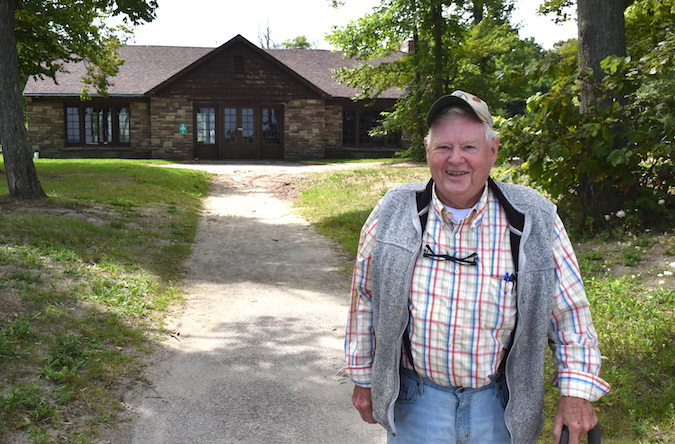
Photos by Tom Rivers: Ed Evans is shown last August at one of the shelters made of Medina Sandstone at Hamlin Beach State Park. The park was indicted into the Medina Sandstone Hall of Fame in 2023.
Dave Miller describes a kiosk on Medina sandstone which will be placed in the Hall of Fame for visitors to use.
MEDINA – Ed Evans, a retired teacher from Hamlin, has become a passionate speaker about Medina Sandstone and he gave a stirring address last week to the Medina Sandstone Society during its annual meeting at the Comfort Inn.
Evans, 82, has now given 239 presentations about Hamlin Beach State Park, how its many Medina Sandstone buildings were built by the Civilian Conservation Corps which was established there in 1935. The park’s buildings, headwalls, culverts, drinking fountains and fireplaces are made of Medina Sandstone.
Evans intended to retire from given the presentation. But he made an exception last week for the Sandstone Society. The group last October honored him with an inaugural “Heritage Award” for his 32 years of work in uncovering the sandstone legacy at Hamlin Beach.
Evans’ interest piqued about the park after he became the liaison to Hamlin historian Mary Smith in 1985. At that time she was planning a reunion for 40 CCC guys who were still alive. Evans taped the event. He spent every year after that trying to be allowed to get on CCC site, but the park fought him all the way, he said. Finally, a new park manager was interested in the site and the clearing began.
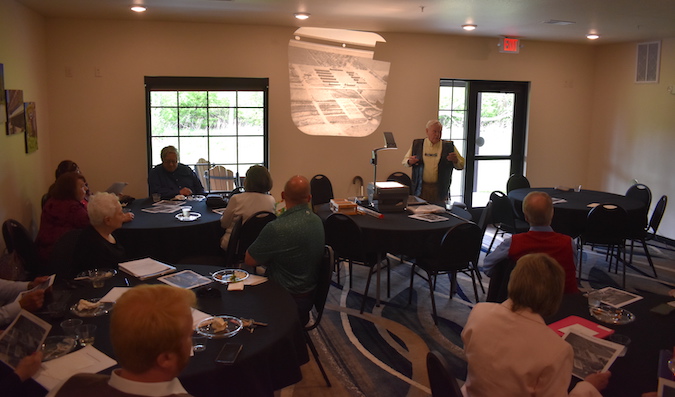
Guest speaker at the Medina Sandstone Society’s annual meeting Wednesday night was Ed Evans of Hamlin, who talked about the Civilian Conservation Corps which existed at Hamlin Beach State Park in the late 1930s and early 1940s. Much Medina Sandstone was used throughout the park. Evans was honored with a “Medina Sandstone Heritage Award” last October by the Medina Sandstone Society for his efforts to chronicle the history of Hamlin Beach.
“Ed remains proud of the work the CCC accomplished – about 80 years after they did the work,” said Dave Miller, a board member and former president of the Sandstone Society. “Starting in 2008, Evans and his wife Sue and friends began clearing away decades of thick underbrush and fallen trees on the eight-acre site which was used as a POW camp after the CCC closed. Over the next 10 years, they carefully mapped the camp buildings and pieced together much of the camp’s history.”
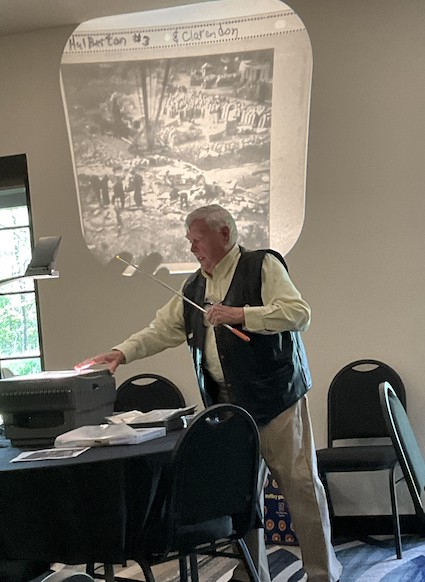
Photo by Dave Miller: Ed Evans marvels at the accomplishments of the CCC crews who built an everlasting state park in Hamlin. He gave a 40-minute presentation to the Medina Sandstone Society. He said he could talk for hours about the CCC workers and the POW camp in Hamlin.
The CCC camp constructed at the park in 1935 was part of a program by President Roosevelt to provide poverty relief from the Great Depression. Evans said the Hamlin CCC camp was the second largest in Western New York, down to the Pennsylvania line. He said there were more than 4,500 CCC camps in the United States and its territories. If there remain four sites in each state as well preserved as Hamlin’s site, Hamlin’s camp would be rated one in 200 of the most unique CCC camp sites in the country, Evans said.
He added Hamlin’s camp was also one of only 377 WWII prisoner of war branch camp sites in the United States. Most of them are now only marks on maps or roadside historical markers. Very few have spawned museums or a reconstructed building, Evans said. If each of the 46 states that had POW branch camp sites still had one site that had not been contaminated by urban sprawl, that would make Hamlin’s site rank one in 46. But only a few of those were also former CCC camps, which would place Hamlin uniquely in the top 10 historical sites of its kind in the country.
Young men who worked at the CCC camp were paid $30 a month. Many were not yet 18 and got to keep $5, while $25 went to their families, Evans said. The young men were fed, clothed and provided with educational and recreational opportunities. The camp was closed when the war was over.
Evans said when the CCC program was discontinued in 1941, most of those more than 4,000 camps were completely dismantled.
“Ours survived,” Evans said.
Early in 1944, the camp was modified to accommodate German prisoners of war. An eight-foot high barbed wire fence was erected, guard towers were put in place and the enclosed area was lighted. CCC cots were replaced with bunk beds so 400 prisoners could be housed.
The first German POWs arrived June 30, 1944 and stayed until the camp closed Jan. 11, 1946.
Unlike most other similar historical sites, Evans said the footprint of this camp and buried artifacts remained intact, untouched by post-war construction projects. Dense vegetation protected the site for 65 years, until volunteers began slowly turning it into a history trail.
In 2014, the history trail at the former CCC POW camp was opened.
Evans shared a slide show of photos of CCC workers he has accumulated and pictures of POWs. Most of them were from Mary Smith’s collection, which she left him when she died.
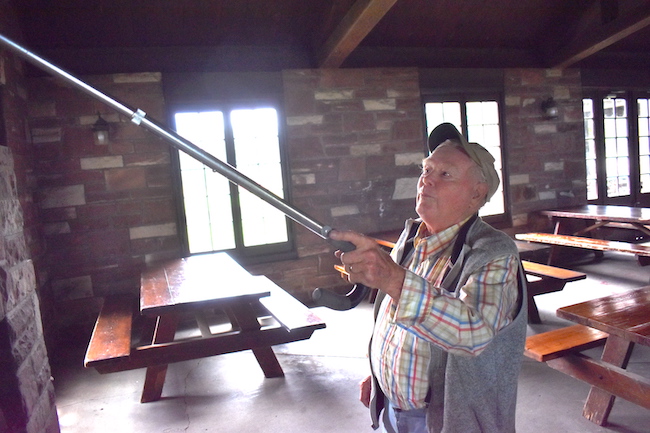
Photo by Tom Rivers: Ed Evans gives a tour of Hamlin Beach State park last August and notes some of the fine workmanship in one of the shelters. Evans is hoping to train his successor to give tours of the park and detail the history of the CCC.
He also located 90+ year-old Hazel Lake who has visited and walked around the entire Hamlin CCC site on three different occasions, clutching a 1937 photo of her late husband George posing in from of a CCC barracks. On each visit, she experienced a little more of what George must have felt when he lived in that camp. This was important to her because every weekend George walked from Hamlin to Medina and back to visit her, his 17-year-old sweetheart. He wore out a pair of shoes in the process and more than once got assigned extra KP for getting back to camp after Sunday night curfew.
Evans talked about Medina Sandstone that was used to build all areas of the park. A huge pile of sandstone was found while cleaning up the area for the history trail. He said every scrap of sandstone was used for something. Nothing was wasted.
“Letchworth, which also had a CCC camp and sandstone buildings, and Hamlin don’t realize what they have,” Evans said. “The history of Medina Sandstone should be made into a documentary which would run for two or three days.”
The Medina Sandstone Society last year inducted Hamlin Beach Satte park into the Medina Sandstone Hall of Fame.
Dave Miller, who serves on the Hall of Fame Committee, said Sandstone Society created a new Heritage Award last year to recognize a community act or individual who contributed to our understanding of local history and preserving it. Evans was the first recipient. (Jennifer Wells-Dickerson also was honored with the award. She has documented the efforts of her great-grandfather, Pasquale DiLaura, who was a stone cutter, business owner and promoter of Medina Sandstone. He operated a quarry in Clarendon and the stone from that site was used for Hamlin Beach and the Lake Ontario State Parkway bridges and culverts.)
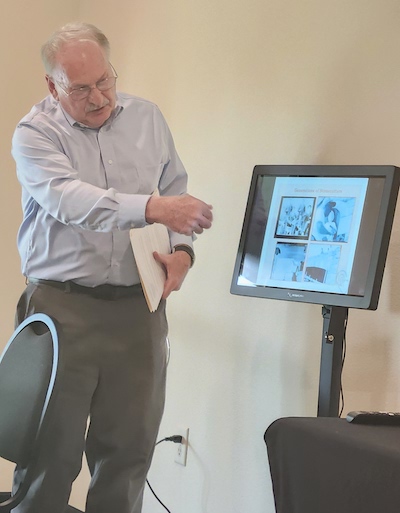
Photo by Ginny Kropf: Dave Miller describes a kiosk on Medina Sandstone which will be placed in the Hall of Fame for visitors to use.
Sandstone Society vice president Matt Holland conducted the annual business meeting, and introduced two new members to the board. Jesse Cudzilo serves as director of the YMCA in Medina. Michael Lepkyj is a technology teacher in the Medina school district.
Holland asked for reports from the various committees within the Sandstone Society.
Peggy Schreck reported she had received a letter from a company in Buffalo hired by the Erie Canalway Heritage Fund, who is organizing the 2025 World Canals Conference in September 2025. They are planning a day of field sessions and want Medina to be one of their sessions.
Miller announced the Hall of Fame nomination period had begun and names may be submitted online. He said he and Jim Hancock will begin visiting sites in June. Hub editor Tom Rivers will be the next chair of the Hall of Fame Committee, he said.
Miller also showed a new kiosk which will be installed in the Hall of Fame. Visitors only have to touch the screen to read about sandstone buildings in the area or watch a video. Miller hopes they will be able to place others in libraries and other public buildings.
The Sandstone Society is now on Instagram, Miller said.
Sue Holland, Kathy Blackburn and Gabrielle Barone are on the Events Committee and would welcome help from the community with special events, such as mailing newsletters and organizing the Hall of Fame luncheon at Bent’s Opera House. It is hoped volunteers would consider helping with special projects and/or joining the Sandstone Society by logging on to their website.
Holland recalled events they have done in the past, going back to 2008 to remember the late Bob Waters, a founder of the Sandstone Society who thought tours were meant to promote sandstone, not be a fundraiser.
She said they thought of ways to put information on the Medina Sandstone Society out in the public, and decided on walking tours.
“They were very successful, but we exhausted our locations,” Holland said. “So then we went to Boxwood Cemetery, which has a lot of sandstone markers and a sandstone chapel. We were fortunate to have Bill Lattin, former Orleans County historian, lead these informative tours.”
In 2018, the Sandstone Society decided to do a bus tour, and hired a small 30-passenger bus to tour Medina, Clarendon, Holley, Albion, Mount Albion Cemetery and St. Joseph’s Cemetery.
“We got brave the next year and rented a real bus,” Holland said. “We went to Buffalo and toured the Richardson complex which had recently opened. We also saw some of the Hall of Fame buildings in Buffalo. In 2023, we decided to go east, and visited Rochester and Sonnenberg Gardens. This year, we are going back to Buffalo and the Richardson complex.”
Holland said the winner of the John Ryan Scholarship will be announced by Medina High School this Friday. This year the students were asked to make brochures advertising Medina Sandstone or talk about cathedrals made of the local sandstone.
The next meeting will be at 5:30 p.m. July 17 at the Walsh Hotel.










































































